|
Winmate M133WK Rugged Tablet PC
Major tech and functionality upgrades for Winmate's feature-rich, full-size 13.3-inch rugged tablet for professional-grade Windows work out there in the field
(by Conrad H. Blickenstorfer, with photography by Carol Cotton)
Modern-era tablets began with the Apple iPad in 2010. The iPad had a 10-inch screen and that size has remained the most popular because it's larger than any smartphone, but not so large as to be too big and heavy to casually carry around. There are, however, tasks that are best done on bigger screens, even if it comes at the cost of reduced mobility and higher weight. As a result, some manufacturers of rugged tablets carry large-screen tablets in their lineups. Among them is Winmate, which has been offering its big M133 tablet platform for several years. The M133WK is the latest and most technologically advanced model in the lineup, and in this article we're presenting an in-depth analysis of Winmate's big 13.3-inch tablet with all the latest technology.
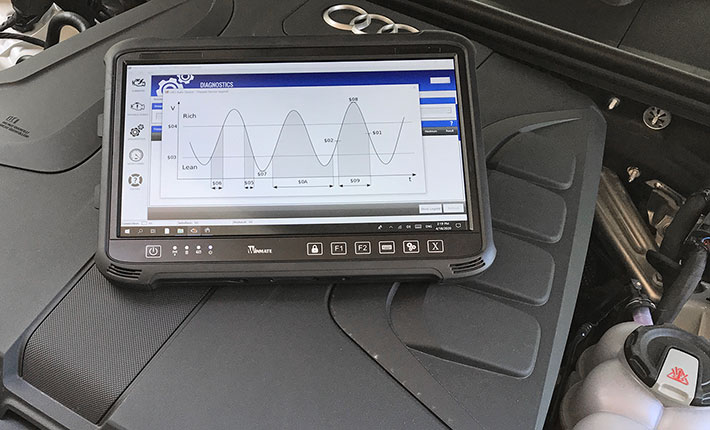
So what is the Winmate M133WK? An elegantly designed, big tablet computer that's fully rugged, equipped with one of Intel's powerful but remarkably efficient 8th generation Core processors, a bright high-quality and satisfyingly large 13.3-inch display, full ruggedness, and extensive onboard connectivity.
When Winmate initially introduced the M133 tablet platform, their media release said, "When selecting technology for use in a volatile environment, choosing between the portability of a tablet and the screen size of a laptop can be a difficult call. The larger screen size of the laptop provides greater visibility, but tablets offer greater durability and portability." The clear implication, of course, is that Winmate M133 tablets deliver both.
The role of the M133 tablet platform in a "Post PC" world
There used to be desktops and laptops and cellphones, each optimized for clearly defined sets of tasks. Work was done on the desktop. A laptop was a desktop for the road. And a phone was for making phone calls. First the smartphone and then the tablet changed all that. Desktops became viewed as old-school, to be replaced by ever lighter laptops. Those, in turn, are increasingly replaced by tablets. And smartphones have become computers one can also make a call on.
As it turned out, the world isn't quite ready to be "Post PC." And smartphones and consumer tablets can't do it all. So the quest these days is that of finding the right tool for the job. Desktops, laptops, tablets, smartphones — each does some things well and others not so well or not at all. And the challenge is to extend the functionality of each of those platforms, making them useful for the broadest possible range of tasks.
What Winmate did with the M133 platform was creating a tablet form factor that is large and powerful enough to do any kind of Microsoft Windows-based work. One can use Windows on a tiny screen, but not very well and not very productively. Hence this tough, rugged tablet with a screen larger than most. To provide a visual of how big the M133WK is, below are, from left to right, a 5.5-inch Apple iPhone 7 Plus, a 9.7-inch iPad Air 2, the big 2nd-gen 12.9-inch iPad Pro, and then the rugged Winmate M133WK with its 13.3-inch display.
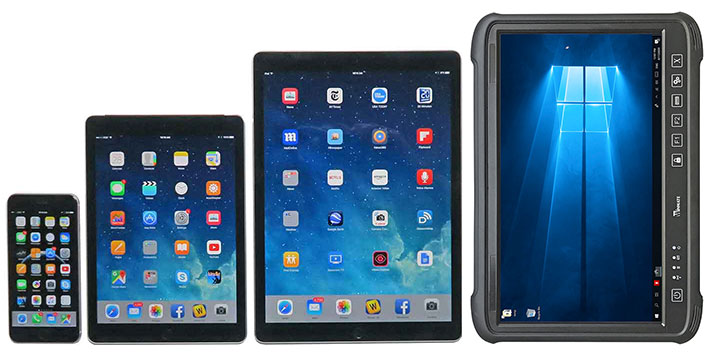
But isn't such a big, tough tablet too bulky and heavy to be truly useful in the field? That depends. The Winmate M133WK has a footprint of 13.3 x 9.4 inches. That's smaller than that of most full-size laptops people take everywhere. While it's substantial, the Winmate tablet is only 1.18 inches thick. And while most full-size laptops are on the fragile side, the Winmate tablet definitely isn't. At about 5.3 pounds, Winmate's 13.3-inch tablet isn't a lightweight, but it's entirely manageable.
Below is a look at the Winmate M133WK from the front and from all four sides. It's instantly obvious that this is a rugged device with ample protection against drops, spills, and all-day use out there in the field and on the job.
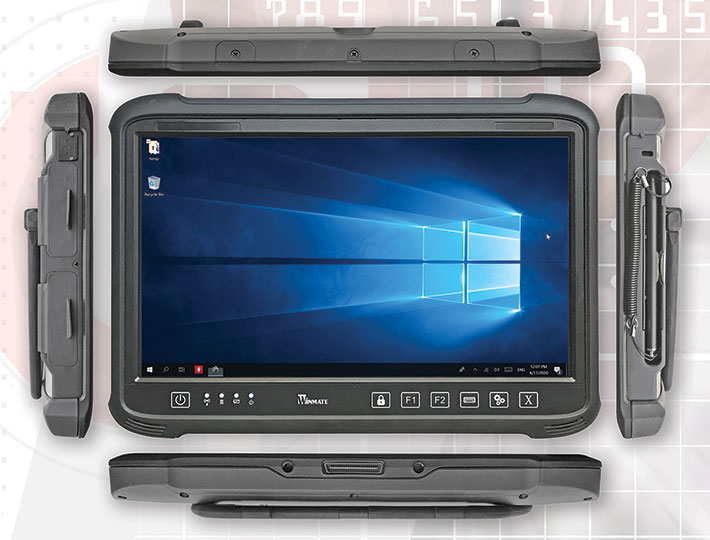
Note that while consumer tablets generally don't have more than the absolute minimum of hardware buttons, the M133WK has six membrane hardware buttons, with each of the programmable ones capable of performing two separate functions via short or long push. The bezel design suggests that Winmate can alter the labeling of those buttons per customer requests.
The below picture shows a close-up of the left side of the M133WK, with the protective port covers removed. There are three I/O blocks on this side, each protected by a rubberized plastic door with a double-lipped pressure seal. This type of door provides a very good, tight seal as long as it's firmly pushed into place. Opening is easy thanks to little rubber pull flaps on each door.

From left to right, the left side of the tablet provides:
- a USB 2.0 Type A port (behind cover)
- a USB 3.0 Type A port
- a SDXC Card reader
- a USB 3.1 Type C port (that's the new reversible kind)
- two full-size USB 3.0 ports (you can always tell 3.0 because it's blue)
- a gigabit RJ45 LAN jack
- the power jack
The right side of the tablet shows just how configurable the Winmate M133 platform is. Earlier models we had in our lab had the scanner as well as USB and LAN ports on the right side. However if that many ports are not needed by a customer or an application, Winmate can easily replace it with something that is needed. The sample M133WK Winmate sent us for review used the right side for a garage for the tethered stylus. For applications that require frequent use of the stylus, that's much handier than the little fabric loop in the back we've seen on oter M133 models.

As far as the port covers go, they are well designed, easy to operate, and they get the job done. We wold, however, like to see the covers clearly labeled, so users won't have to memorize/guess which ports are where.
A look inside the Winmate M133WK
The backside of the Winmate M133WK looks impressive. It is not the usual flat, flush bottom with a couple of access doors, but a surface that's designed, structured and contoured for the various jobs at hand. It's an example of form following function, as opposed to squeezing function into whatever form is deemed fashionable at any given time.
 The finning in the magnesium, for example, isn't just decorative. It's there because that part of the housing dissipates processor heat, and finning increases heat-dissipating surface area. The finning in the magnesium, for example, isn't just decorative. It's there because that part of the housing dissipates processor heat, and finning increases heat-dissipating surface area.
There's the battery compartment for the flush-fitting 87.3 watt-hour (14.8 Volt, 5,900 mAh). It's rectangular, 5/8th of an inch thick, and snaps into place thanks to a springloaded lever that can then be locked via a second lever. There is no battery compartment cover or seal. Sealing to the interior of the tablet is at the point of the actual battery contacts.
The only access cut-out on the back of the unit is a thick, heavy, finned aluminum door secured with four small screws against a pressure seal. Underneath are two E-keyed M.2 expansion connectors as well as an M-keyed M.2 2280 PCIe slot is for a second SSD. The two small M.2 slot in our unit were occupied by an Intel 9260NGW WiFi + Bluetooth module and, interestingly a secondary WiFi/Bluetooth module from Azurewave.
The next thing to come off are the two protective bumpers along each long side of the M133WK. While they look like they are made of solid rubber, they are actually tough flexible Polymer plastic with a grippy rubberized exterior surface (most likely TPR, which stands for ThermoPlastic Rubber). In addition to providing grip and protection, they also allow Winmate to mount antennae outside the actual metal housing of the tablet, thus making for much better wireless performance.
The tough rotating kickstand of the M133WK comes off easily, too. Its two anchors are secured with two Philips screws each. Note that this is one tough handle. Solid metal, with grippy rubber inserts.
Now we're down to the two halves of the M133WK, and they are held together with a total of 13 Philips screws. Once those are undone, the overall construction of the M133WK is revealed. The backside "bucket" is very substantial cast magnesium. The front is essentially the ABS+PC bezel with a metal plate (aluminum, it seems) attached to it. The front side of the metal plate mounts the display, the back side the main circuit board that's roughly mini-ITX size (6.5 x 5.5 inch (165 x 140 mm).
Below you can see the very strong cast magnesium on the left, and the Polymer top with all of the electronics and the display on the right:
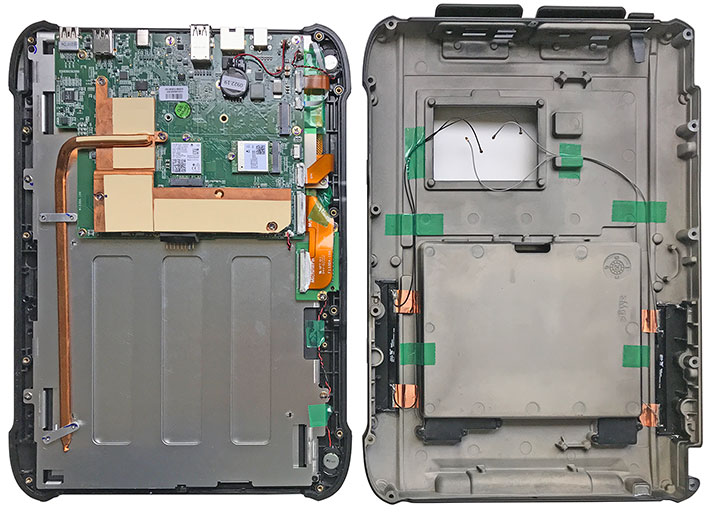
The sealing between the two halves is via a rather delicate tongue-and-groove design that relies on a very thin rubber string seal that goes around the entire perimeter of the tablet, loosely sitting in its groove. This means that when taking the tablet apart, utmost attention must be given to that seal so that upon reassembly it isn't crimped or damaged.
The overall interior design approach very much reminds of Winmate's history and experience in embedded systems where "embedded" PC boards are used in all sorts of settings and connected to all sorts of dedicated peripherals and functionality. In other models of the M133 line, Winmate separates I/O to edge-mounted I/O on the motherboard and secondary I/O on a remote daughter board, but in the M133WK, all primary I/O is on the motherboard.
Given the powerful Intel 8th generation Core processor, one wouldn't be surprised to find a fan in the tablet, but just like earlier versions of the tablet, the M133WK doesn't need one. Removal of heat generated by the processor and other electronics is handled by advanced thermal management. An extensive copper heat spreader conducts heat into the tablet's massive magnesium housing, and a substantial 12-inch copper heatpipe routes heat into the tablet's internal metal mounting plate.

The picture above shows two details. On the left the extensive use of copper plates and tubing to spread and remove heat generated by the processor and ancillary electronics. This allows the powerful Winmate tablet to operate without a fan. On the right is an example of Winmate's prodigious use of silicone glue to secure connectors so that they will not come loose even under the harshest vibration or impact. If need be, the silicone can be removed and reapplied.
The picture below shows more interesting details. On the left you can see how the tongue-and-groove design is implemented on the back and the front parts of the tablet. On the right is a close-up of the two WiFi/Bluetooth modules, each with primary and secondary antenna ports.

And, as is expected in a next-gen tablet, there's a full complement of sensors. An ambient light sensor, G-sensor, gyrometer, and e-Compass are all present and ready for duty in tablet apps and solutions.
Fanless even with powerful Intel 8th generation Core processor
Keeping up with Intel's rapid-fire release of ever more powerful and ever more efficient Core processors isn't easy. With the initial models of the M133 tablet platform back in 2015, 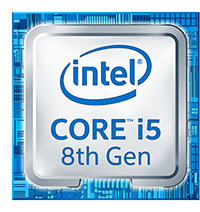 Winmate went with then new "Broadwell" 5th generation Core i5-5200U processor. Intel's 5th generation was a major step forward, as the company had succeeded in miniaturizing process technology from the 4th generation's 22nm to 14nm). Winmate went with then new "Broadwell" 5th generation Core i5-5200U processor. Intel's 5th generation was a major step forward, as the company had succeeded in miniaturizing process technology from the 4th generation's 22nm to 14nm).
Four years later, when we tested the Winmate M133K in 2019, Intel had introduced the 6th, 7th, 8th, 9th, and even 10th generation of Core processors, but progress had come in far smaller increments than during the first few generations of Intel's high-end mobile chips. Intel remained stuck on 14nm process technology for years and mostly concentrated on refining and optimizing existing CPU microarchitectures. "Kaby Lake Refresh," part of the 8th generation of Core processors, had brought quad-core processors to Intel's mobile Core lineup, but for the M133K Winmate decided to stay with a 7th generation "Kaby Lake" Core i5-7200U. We had hoped for a quad-core 8th generation equivalent such as the Core i5-8250U, and that is now finally here in the M133WK.
The big deal is that the latest version of the big M133 tablet is now powered by a genuine Intel quad-core Core processor, and one that, although it is still part of the 8th generation, is actually part of the refined and more advanced "Whiskey Lake" series (yes, Intel makes it quite confusing to keep up with their code names). In our testing of various high-end mobile computers, "Kaby Lake Refresh" had already proven that four cores are definitely better than two, but the i5-8265U in the M133WK is actually better than the i5-8250U we had hoped to find in its predecessor M133W.
With the additional refinements, maximum turbo clock speed in the i5-8265U had gone up to 3.9GHz, more than the i5-8250U's 3.5GHz, and much more than the dual-processor ir-7200U's 3.1GHz.
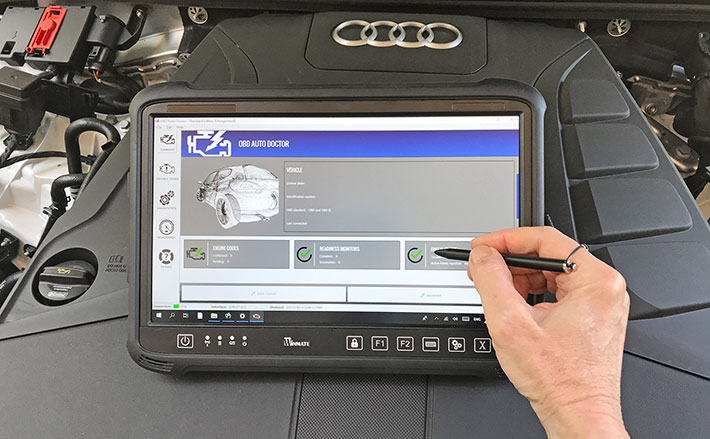
To provide an idea of where the Winmate M133WK tablet stands in terms of performance compared to the already quite powerful M133K earlier model and the original M133W, we ran our evaluation unit through our standard benchmark suites, those being PassMark 6.1, PassMark 9.0, and CrystalMark. And here is what we found:
|
Winmate M133WK vs M133K vs M133W Benchmarks
|
|
PERFORMANCE COMPARISON
|
Winmate
|
Winmate
|
Winmate
|
|
Model (version tested)
|
M133WK
|
M133K
|
M133W
|
|
Year tested
|
2020
|
2019
|
2016
|
|
Processor
|
Intel Core
|
Intel Core
|
Intel Core
|
|
Processor Model
|
i5-8265U
|
i5-7200U
|
i5-5200U
|
|
Code name
|
Whiskey Lake (8th gen)
|
Kaby Lake (7th gen)
|
Broadwell (5th gen)
|
|
Cores/threads
|
4/8
|
2/4
|
2/4
|
|
CPU Speed
|
1.60 GHz
|
2.50 GHz
|
2.20 GHz
|
|
Max. CPU Turbo
|
3.90 GHz
|
3.10 GHz
|
2.60 GHz
|
|
Thermal Design Power (TDP)
|
15 watts
|
15 watts
|
15 watts
|
|
Intel Graphics
|
UHD Graphics
|
HD 620 Graphics
|
HD 5500 Graphics
|
|
Installed storage
|
1TB PCIe NVMe SSD
|
256GB SATA SSD
|
128GB SATA SSD
|
|
CPU Mark 6.1
|
8,326.7
|
4,451.7
|
3,538.4
|
|
2D Graphics Mark 6.1
|
464.4
|
275.3
|
461.3
|
|
Memory Mark 6.1
|
2,369.0
|
1,275.0
|
981.3
|
|
Disk Mark 6.1
|
16,727.7
|
5,006.7
|
2,887.8
|
|
3D Graphics Mark 6.1
|
610.3
|
292.5
|
321.5
|
|
Overall PassMark 6.1
|
6,158.4
|
2,506.5
|
1,812.7
|
|
CPU Mark 9.0
|
7,784.5
|
4,471.6
|
NA
|
|
2D Graphics Mark 9.0
|
657.2
|
587.4
|
NA
|
|
Memory Mark 9.0
|
2,400.7
|
1,607.4
|
NA
|
|
Disk Mark 9.0
|
28,141.2
|
4,412.6
|
NA
|
|
3D Graphics Mark 9.0
|
1,090.6
|
858.1
|
NA
|
|
Overall PassMark 9.0
|
3,511.0
|
2,438.0
|
NA
|
|
CrystalMark ALU
|
73,559
|
45,182
|
41,977
|
|
CrystalMark FPU
|
54,520
|
47,851
|
39,976
|
|
CrystalMark MEM
|
57,451
|
33,055
|
28,556
|
|
CrystalMark HDD
|
90,405
|
45,978
|
33,994
|
|
CrystalMark GDI
|
18,905
|
14,676
|
14,409
|
|
CrystalMark D2D
|
6,606
|
5,665
|
6,815
|
|
CrystalMark OGL
|
10,865
|
10,635
|
10,106
|
|
Overall CrystalMark
|
312.311
|
203,042
|
175,833
|
The results say it all. The new Winmate M133WK is blisteringly fast. With four cores at its disposal instead of just two, Winmate's big tablet has entered into a new performance league. However, some explanations of the benchmark results are in order.
First, we continue to use PassMark version 6.1 for compatibility's sake. This way, we can compare benchmarks of the many hundreds of rugged devices we've tested here at RuggedPCReview over the years. That said, technological advances have made the weighting of the different tests in version 6.1 no longer less representative of actual real-world performance. As fast as the new M133WK is, it's not overall 2.5 times faster than the PassMark 6.1 would suggest. PassMark version 9 is much more representative. 1.4 times faster is what it feels like.
Second, while the CrystalMark benchmark is old, it actually is quite representative of single core performance. So each of the cores in the new chips gets quite a bit more work done that each core in the older chip.
Third, what's with the massively faster disk performance in the M133WK? That's real, and it comes from Winmate's switch from the SATA interface to the much quicker PCIe NVMe interface. It's been available for a while now, we've been advocating the switch for a long time as it's inexpensive and has a big impact on overall performance, and we're finally start seeing it in more high-end devices. Well done, Winmate!
Overall, the Winmate M133WK is right up the with the highest performance rugged tablets available on the market today. And thanks to its super-fast disk performance, it does it all with the relatively low-end i5-8265U chip. With the i7-8665U chip that some of the competition uses, the M133WK would, as of now, be the absolute king of the hill.
Amazingly low power consumption
In the dawn of rugged the rugged laptop era, users were happy to get two or three hours of runtime on a charge. And ditto for users of early Tablet PCs. That all changed with the iPad that lasted 10 hours between recharging. Today, full-shift operation and more is expected from most mobile computing devices. This makes designing mobile computers an exercise in compromise with careful balancing of size, weight, performance, cost and battery life. It also requires good market research and a good deal of guessing: Will a big battery that lasts ten hours make the device too thick and heavy? Will a lighter design with a smaller battery lead to complaints over insufficient battery life?
Such contemplations are perhaps a bit less of an issue when designing an inherently large device like a fully rugged tablet with a big 13.3-inch display. "Large," of course, is relative. The M133WK is doubtlessly a big tablet, but it's still only 1.2 inches thick. That's in part made possible by a relatively slender battery. But that battery still packs 76 watt-hours. So what battery life can one expect?
|
Winmate M133WK Power Draws (at idle)
|
|
Backlight level
|
0%
|
50%
|
100%
|
|
Power Saver
|
3.6 watts (24.3 hrs)
|
4.2 watts (20.8 hrs)
|
4.8 watts (18.2 hrs)
|
|
Max Performance
|
3.8 watts (23.0 hrs)
|
4.5 watts (19.4hrs)
|
5.5 watts (15.9 hrs)
|
Winmate claims "more than 10 hours" of operation on a charge of the M133WK's 14.8 Volt, 5,9000mAH, 87.3 watt-hour Lithium-Polymer battery that fits flush into the backside of the tablet. To see if that estimate seems doable, we tested the M133WK with PassMark's BatteryMon 2.1 utility and found the following:
With the tablet set to the Windows "Best Battery Life" mode and the display backlight set to its lowest, we saw a minimum power draw of just 3.6 watts. With the backlight set to 50% we saw 4.2 watts, and with the backlight set to its brightest setting, power draw rose to a still amazingly low 4.8 watts.
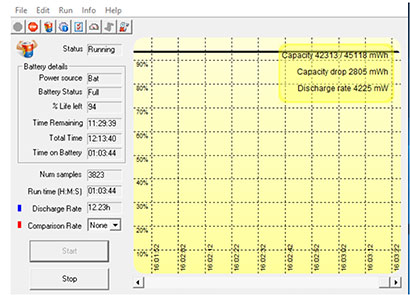 With the Windows "Best Performance" setting, we found a low of 3.8 watts at the lowest backlight, 4.5 watt with average backlight, and 5.5 watts with the backlight at its highest.
With the Windows "Best Performance" setting, we found a low of 3.8 watts at the lowest backlight, 4.5 watt with average backlight, and 5.5 watts with the backlight at its highest.
Dividing the battery's claimed 87.3 watt-hours by the lowest draw we saw (3.6 watts) yields a theoretical battery life of a stunning 24.3 hours. Dividing it by the highest draw we saw (5.5 watts) indicates still 15.9 hours. This range excellent for a full-size rugged tablet, and way more than we've seen in any prior Winmate M133 tablet.
This presents an interesting situation: Both the 7th generation-powered Winmate M133K (6.2 to 10.1 watts) and the 5th generation-based initial M133W (5.4 to 10.0 watts) had much higher power draws than the new M133WK, despite this latest model using a quad-core chip and a much brighter display. If these numbers hold up, the new M133WK runs twice as long on a charge!
Excellent display
In the past, Winmate often used the excellent Hydis HFFS display technology. HFFS (High Performance Field Fringe Switching) impressed us for years with its brilliance and full 180-degree viewing angle from all directions. Unfortunately, Hydis, which became part of E-Ink, no longer offers HFFS LCD panel, and so Winmate — intent on perpetuating its history of providing excellent displays — now uses Chi Mei/Innolux (for the M133K) and Panda (for the M133WK) screens.
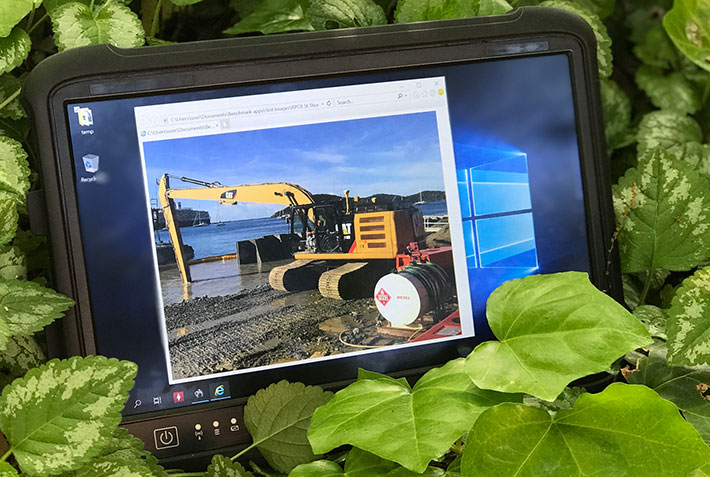
The M133WK uses a 13.3-inch LC133LF2L03 Panda display based on Oxide TFT LCD technology that combines the excellent viewing angles of IPS displays with the resistance to color shifts of twisted nematic (TN) cell designs. Spec sheet luminance is 500 nits (our measurement confirmed the 500 nits), significantly more than the 300 nits in the Winmate M133W we tested last year, and much more than the 200-250 nits of your average laptop. Although the standard display is plenty bright enough for most outdoor work, Winmate offers an optional 800 nits display.
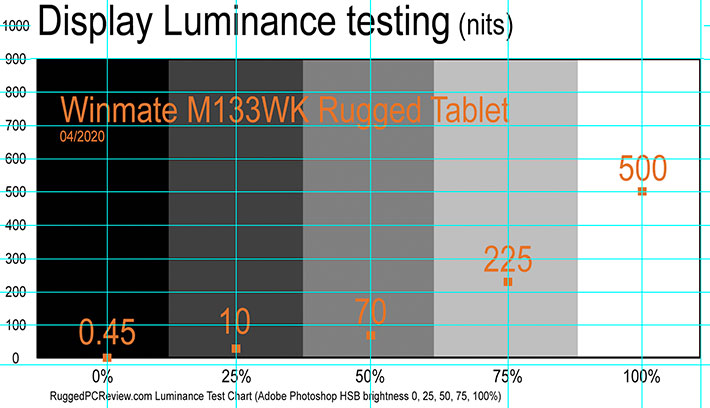
The M133WK offers 1920 x 1080 FHD resolution, which makes for 165 PPI (pixels per inch). Viewing angle is 89 degrees from all sides, which means it's for all practical purposes perfect.
In everyday use, the M133WK display is very good. It's sharp enough for almost any use although individual pixels, unlike in "retina" displays, are still visible. It's bright and vibrant. The viewing angle is indeed perfect. There are no color of contrast shifts. The is a slight darkening of the image when viewed from extreme angles.
To see how well it works outdoors, we compared the Winmate M133WK with a 2nd gen Apple iPad Pro 12.9 whose 2732 x 2048 12.9-inch direct-bonded display is said to have a luminance of about 600 nits. Placed side by side outdoors on a sunny August morning in a semi-shaded area, both screens remain remarkably vibrant, but the 350 nits W133K is not quite as bright as the 600 nits iPad Pro. Prospective customers use this as a guide on whether to go for the W133K's optional 600 nits display or not.
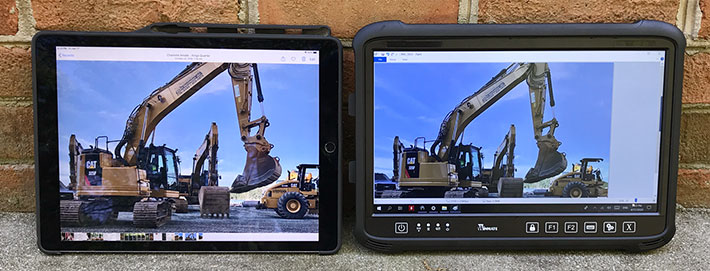
The second picture below demonstrates something every smartphone and tablet user is familiar with: the flipside of those glossy, vibrant capacitive touch displays is that they reflect. The M133WK's display is no different. Angle it this way and the picture is bright and eminently readable. Angle it another way and there's reflection.
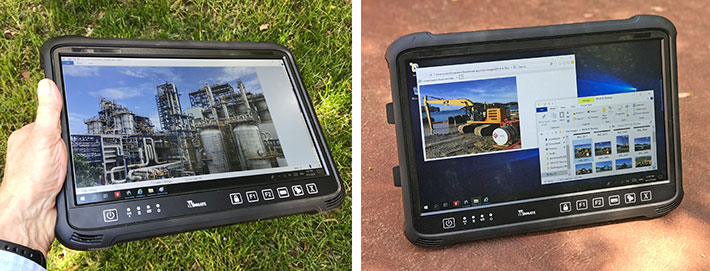
Not everything, however, is optimal on the display front. For best functionality, capacitive multi-touch screens require a generous margin beyond the actual perimeter of the LCD, so that there's room for fingers to tap on things or perform other gestures. That's why virtually all consumer tablets and phones have flush glass fronts. The M133 Series' raised bezel doesn't leave any such space around the LCD and fingers frequently bump into the bezel.
Capacitive multi-touch with switchable modes
The Winmate M133WK uses projected capacitive multi-touch, the effortless touch technology the world has come to love and demand due to the effortless tapping, panning, zooming and pinching the technology allows. When it first appeared, capacitive touch was considered unsuitable for rugged devices because outdoors it can get wet and users may wear gloves, neither of which standard capacitive touch can handle.
During the development process of the M133 platform, Winmate initially planned on using a resistive digitizer, the rationale being that, in addition to the rain and gloves issues, even today a stylus on a resistive touch display offers more precision than capacitive touch.
Eventually, Winmate decided to go with a projected capacitive multi-touch digitizer, but an advanced, modified one that addresses use with gloves and in the rain, as well as more precise stylus operation.
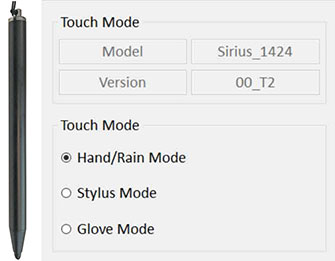 The image to the right shows the M133WK's touch mode selection control panel. This allows users to put the tablet into three different touch modes. The image to the right shows the M133WK's touch mode selection control panel. This allows users to put the tablet into three different touch modes.
- Default is the Hand/Rain Mode which is designed to reject "false" inputs from rain drops or liquids in general.
- Stylus Mode allows the tablet to sense the fine-tipped 4.5-inch capacitive stylus that comes with the M133WK. The stylus is metal and the 3mm tip enables reasonably precise operation. Regular finger touch remains available in this mode.
- Glove Mode allows operating the display with some gloves, depending on material and thickness.
Note that these modes all operate within the constraints of mutual capacitance technology, by tweaking controller sensitivity and applying selective filters. This means there are limits to what can be done.
And the usual procap caveat here: while capacitive multi-touch has become the universal standard for smartphones and tablets, older application software and even Windows 10 itself still often present users with situations where finger touch isn't quite precise enough.
Overall, capacitive multi-touch worked flawlessly on the big M133WK, with none of the hesitation that earlier Windows-based hardware often exhibited with procap. And being able to switch between modes and selecting the optimal one for any given environment is much appreciated.
Ruggedness
Winmate describes the M133WK tablet as "rugged" and with its tough PC+ABS and magnesium case and overmolded TPR corner protection it certainly looks much tougher than all those ever thinner and ever more fragile consumer tablets.
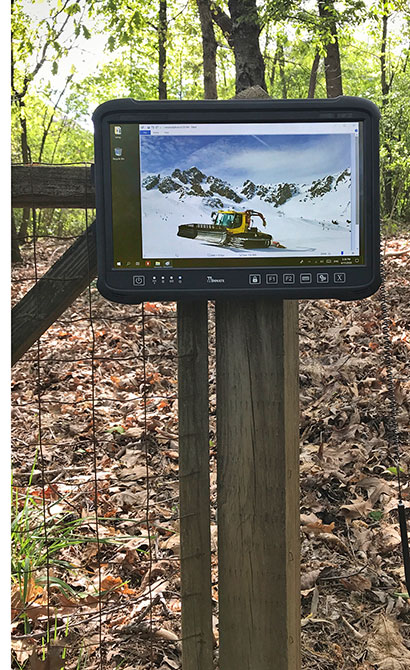 Environmental specs include a fairly wide 14 to 122 degree Fahrenheit operating temperature range (-10 to 50 degrees Centigrade). That's enough to deploy the M133WK almost anywhere.
Environmental specs include a fairly wide 14 to 122 degree Fahrenheit operating temperature range (-10 to 50 degrees Centigrade). That's enough to deploy the M133WK almost anywhere.
The tablet can handle 26 repeated drops from four feet per MIL-STD-810G, 516.6 IV to plywood over concrete. That's relevant because four feet is roughly the height a tablet is held while it's being operated when standing or walking.
It's also remarkable for a tablet as large as this, and a testimony to the tablet's solid construction and excellent exterior protection via rubber bumpers.
Sealing is at the IP65 level. That means the Winmate M133WK is totally protected against dust, and it can also handle low pressure water jets from all directions, albeit with limited ingress permitted.
As long as all seals are in good working conditions and the protective door over the I/O block is closed, the M133WK should easily survive even a downpour. It wasn't the worse for wear after sitting in our proving ground brook and waterfall for half an hour.
In our testing, we actually had the M133WK tablet sit in running water and there was no leakage (of course we tightly closed all the protective covers before this sort of abuse). The capacitive touch screen becomes inoperable while water is running over it or when it sits in water. It works in a bit of rain, but only to a certain extent.
Winmate also claims successful shock testing in accordance with the methods described in MIL-STD-810G 516.6 Procedure I and vibration testing per MIL-STD-810G Methods 514.6 Procedure I.
Overall, there's no doubt that the Winmate M133WK is far tougher and far more durable than than any consumer or even enterprise market tablet. It feels solid and substantial, the protective covers are both easy to close and to close, there's nothing to break off, and even the excellent optional stand/handle seems built to last forever.
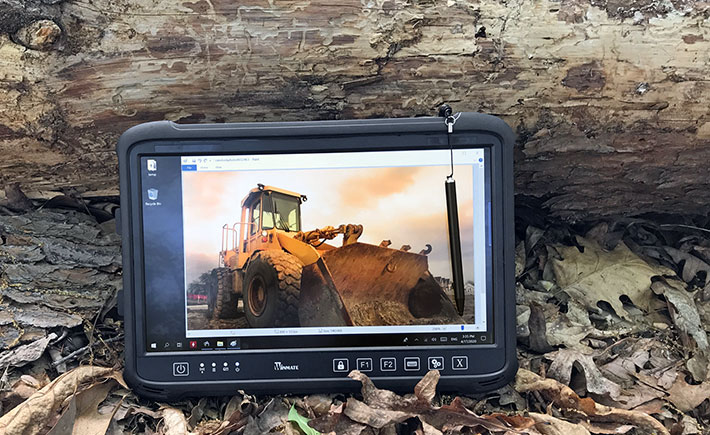
Bottom line: Winmate M133WK
The Winmate M133WK is for those who need a robust, largely invulnerable tablet PC with superior processing power, excellent connectivity, and plenty enough display real estate to handle complex Microsoft Windows work and applications.
Just as Microsoft's Surface Pro and Apple's iPad Pro established a "professional" class of more powerful tablets with larger displays primarily designed for the enterprise market, Winmate is bringing those benefits to vertical and industrial markets with the M133 platform. Field-ready ruggedness and functionality, of course, do come at the price of larger size and higher weight. Weighing 5.3 pounds and being 1.2 inches thick,
the M133WK is a substantial piece of equipment, but one that — thanks to good ergonomics and a very clever kickstand/handle — remains surprisingly handy and easy to use.
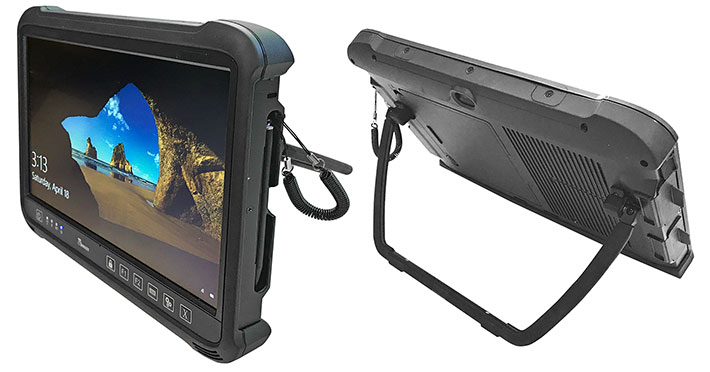
The new M133WK model is equipped with a quad-core Intel 8th generation "Whiskey Lake" Core CPU that offers significantly more performance than any prior M133 model. In our benchmark testing the M133WK scored among the very top of any tablet we've tested. Despite the higher performance, power draw is amazingly low, much lower than in earlier models. Winmate claims more than 10 hours battery life; we saw much more than that.
The M133WK impresses with its large 13.3-inch 1920 x 1080 pixel display that offers a perfect viewing angle from all directions, and shows no annoying color or contrast shifts. The standard 500 nits is plenty bright for almost all outdoor work. The capacitive multi-touch display can be optimized for use with gloves, in the rain, or with the supplied narrow-tip stylus.
Onboard connectivity includes USB 2.0, 3.0, 3.1 Type C, and LAN. The device has optional optional RFID, and supports an optional industrial-grade integrated 1D/2D imager or Smart Card reader.
Thanks to its PC+ABS/die-cast magnesium construction and protective rubber overmoldings, the Winmate M133WK is extremely solid and can handle a good deal of abuse. IP65 sealing means users won't have to shy away from rain, and the tablet has a suitably wide operating temperature range.
Offering vastly improved performance over earlier models, more than full-shift-plus battery life, remarkable ruggedness, a gratifyingly large and overall excellent hi-res display, the Winmate M133WK represents a compelling package for numerous applications that not only require Windows in the field, but also enough performance and screen real estate for professional-grade applications. -- Conrad H. Blickenstorfer, April 2020
Winmate M133WK Rugged Tablet PC Specs:
| Type |
Large-screen rugged Tablet PC |
| Status |
Full review 04/2020
|
| Processor |
1.60GHz Intel "Whiskey Lake" Core i5-8265U (turbo 3.90GHz)
|
| Graphics |
Core i5-8265U: Intel UHD Graphics
|
| CPU Thermal Design Power |
Core i5-8265U: 15 watts
|
| OS |
Windows 10 IoT Enterprise
|
| Memory |
4GB to 16GB DDR4-2400 SO-DIMM
|
| Display |
Sunlight-readable, optically bonded anti-glare 13.3" FHD (1920 x 1080 pixel 166 ppi) AAS/IPS TFT with 500 nits LED backlight and 89° viewing angle from any direction; optionally available: 800 nits display
|
| Digitizer |
Projected capacitive multi-touch with glove/rain/stylus modes; optional active stylus |
| Keyboard |
Onscreen keyboard |
| Navigation |
Stylus, touch |
| Storage |
128GB to 512GB M.2 SSD; optional second 128GB to 512GB M.2 SSD (supporting RAID 0/1)
|
| Expansion slots |
1 x SDXC card, 1 x SIM card, 1 x mini PCI-e |
| Housing |
Rear: die-cast magnesium alloy, all-around elastomeric rubber |
| Size |
13.3 x 9.4 x 1.18 inches (338 x 240 x 30 mm) |
| Weight |
5.5 lbs. (2.5 kg)
|
| Operating temperature |
14° to +122°F (-10° to 50°C) |
| Humidity |
30% ~ 80% (non condensing) |
| Ingress protection |
IP65 |
| Altitude |
Unknown
|
| Shock |
MIL-STD-810G, 516.6 Procedure I
|
| Salt Fog |
Unknown |
| Vibration |
MIL-STD-810G, 514.6 Procedure I |
| Power |
Hot-swappable Li-Polymer 14.8V, 5,900mAH, 87.3 watt-hours ("more than 10 hours")
|
| Cameras |
NA
|
| Sensors |
Est: Light, G-sensor, Gyrometer, e-Compass
|
| Scanning |
NA
|
| Interface |
1 x USB 2.0, 3 x USB 3.0, 1 x USB 3.1 Type C, 1 x gigabit RJ45, power, dock
|
| Wireless options |
M.2 Dual-band Intel 9260NGW 802.11ac and Bluetooth 5.0, Azurewave AW-CB304NF WiFi + BT; optional: u-blox Neo-M8N GPS, 4G LTE mobile broadband
|
| Price |
Inquire https://winmate.com/quick-inquiry.asp |
| Contact |
Winmate Inc. |
| Product page |
Winmate M133WK product page |
| Spec sheet |
Winmate M133WK spec sheet (PDF) |
| Contact |
Winmate Inc.
9F, No.111-6, Shing-De Rd.,
San-Chung District, New Taipei City 241
Taiwan, R.O.C.
Tel: 886-2-8511-0288
Fax: 886-2-8511-0211 |
(copyright 2020 RuggedPCReview.com)
|



